 |
| James Brooks Wasden 1949 |
History as posted in Sons of Utah Pioneers
Submitted by Philip A. Wasden (grandson)
Pioneer's Information
Type of Pioneer: Early Pioneer
Pioneer's Name: Wasden, James Brooks
Birth Place: Scipio, Millard, Utah USA
Date of Birth: Sat, 16 Jul, 1870
Date of Death: Sun, 25 Feb, 1966
Father: John Brooks Wasden
Mother: Anna Sophia Olsen
Spouse: Tilda Christena Christenson
Other Spouses:
Arrived in Utah: Sat, 16 Jul, 1870
Education: Elementary level
Profession: Farmer
Honors: Honored by Governor Hunt of Wyoming as Wyoming Pioneer; Grand Marshal in Parade
Civic Activities: Community Leader; director in the Elk Canal Company, was elected road supervisor for District No. 3, Park County, Wyoming on November and was reelected in November 1916.
Church: Bishop for 16 years of Penrose Ward; Superintendent of the Penrose Sunday school from the time of its organization, December 24, 1905 to October 19, 1913.
Authentic Mormon Pioneer: No (Age criteria not met?)
Pioneer's Pictures
Excerpt from Pioneer Story
Early day settler and pioneer of Northern Wyoming; Built the first house in Penrose, WY; Bridge builder in Yellowstone National Park; Met U.S. President Teddy Roosevelt; Lacked formal education however, excelled as a scriptorian and a prolific reader.
Full Pioneer Story
A HISTORY OF JAMES BROOKS WASDEN
Submitted By: Philip Asay Wasden
History of James Brooks Wasden
Transcribed by Philip A. Wasden. Phil is the grandson of James Brooks Wasden and Tilda Christena Christensen.
James Brooks Wasden, son of John Brooks and Anna Sofie Olsen Wasden was born July 16, 1870, at Scipio, Millard County, Utah. His mother gave birth to twin boys and named them James and Peter for her two brothers. Peter died soon after birth and seven days later the mother passed away.
 |
| Anna Sophie Olsen Wasden |
There was a real struggle in central Utah in those days to find the wherewithal to keep body and soul together. The family moved about a great deal in trying to provide the creature necessities of life. They lived at Brooklyn (named for James' father), back at Scipio; then to Glenwood and finally to Gunnison. As it was necessary for his father to work much of the time away from home, James, the oldest boy in the family, felt it his duty to take care of the chores and work around the home. When he was about six years old, his mother made him a suit of clothes out of cloth. This was to replace one she had made from buckskin that he had ruined by wading in the water. The buckskin first stretched and then shrunk until he could not get into it. As soon as he was old enough, his father took James with him on freighting trips, railroad grading jobs, timbering, or whatever work was available.
The frailties of childhood seemed to plague James through life, yet he was an individual of tremendous endurance and physical ability. When he was fifteen he went to work for his uncle Orson herding sheep. At that time, wages for a man's work were twelve to fifteen dollars per month. He was taken out to the camp wearing one shoe and one boot. They unloaded his tent, a skillet, sourdough starter and a few meager supplies and for six weeks, he did not see another human being. One day, the following spring, another band of sheep was driven near his and in trying to keep them from mixing, he became overheated. He drank from a cold stream, which made him very sick. He was unable to work for some time after that.
By Winter time he was feeling better but not well enough to work, so he went to school for a short time. This was his only formal education. In spite of this lack of schooling, he became well read and searched constantly for information of the world about him.
The following Spring (1887), James and his father left Gunnison for western Colorado, having heard of railroad work to be had there. While they took provisions with them for the trip, they were able to buy eggs for five cents a dozen in Emery County, Utah. The Rio Grande was building the railroad from Denver to Salt Lake at the time. They worked on the grade, freighted to Glenwood Springs and did other jobs that were available.
Sickness was James' lot again that first summer in Colorado. Home remedies did not give much relief from the trouble. His father gave him a team of horses as he wished James to stay with him. Wages were low, but he sent part of his earnings home to his mother to help with the family. After the work shut down for the winter, they finally got a contract for getting out timber that lasted until nearly Christmas in 1888, when they returned to Gunnison.
(A note on the Colorado job: "While we were in Colorado hauling wood for the C.C. & I. Company, it was a cold winter with temperatures of 25 to 35 degrees below zero. Lottie (a sister) cooked for us and stayed until the job was done. Then we went to Lake Ivanhoe and contracted to stock a sawmill. We moved into some quarters that had been made by some woodsmen when the Midland Railroad first built through from Leadville to Aspen, under the Maughn tunnel. The quarters were built from ties.")
 |
| Grandma and Grandpa Wasden possibly Gunnison Utah |
When James arrived back in Gunnison, he built a log house for his mother. It was only two rooms but much more than she had before. While working on this project, the ax slipped, cutting the inside of his leg near the ankle very badly. His mother took care of him and did all she could to heal the cut.
Next, they bought some cows and went to Grass Valley to operate a dairy, making cheese. In the fall they sold out and secured work on the railroad south of Milford that was being built from Salt Lake into Nevada. This road was built by Clark of Butte as the Salt Lake, Los Angeles and San Pedro. Later, it became part of the Union Pacific system.
 |
| James Brooks Wasden |
In the fall of 1899 the depression struck the country so severely that employers were able to pay only a small part of wages due with money. James managed to get some merchandise and clothes to send home. He then left for Butte, Montana, hoping to get work in the mines. He found them closed. His time was then spent in Montana, Northern Wyoming, and Yellowstone Park until work shut down for the winter of 1896 for lack of funds. The search for employment then took him into northern Idaho near Bonner's Ferry. While working at a log camp some forty miles up the river, he received a letter telling of the serious illness of his mother. He walked to town and took the train for home, arriving a few days before his mother passed away on March 22, 1897.
James went to Butte until the following spring when re returned to Gunnison for his marriage to Tilda Christina Christenson at Manti, Utah on March 9, 1898. To this union, seven children were born: David John, December 6, 1898; Sofe Christine, May 27, 1901; Brooks Fulton, November 27, 1903. These three children were born at Gunnison, Utah. The four youngest, Minnie Arrilla, October 4, 1906; Elna Tilda, September 15, 1908; James Orvil, May 27, 1910; and Lucinda, August 20, 1913, were born at Penrose, Wyoming.
 |
| James Brooks and Tilda Christena Wasden |
 |
| James Brooks Wasden 104 Missionary Set apart by J. Golden Kimball 16 Mar 1898 |
 |
| Letter of Acceptance of Mission Call written to President Woodruff. |
 |
| Church of Jesus Christ of Latter-day-Saints Missionaries - 1898 James Brooks Wasden - Gunnison, Utah top row 3rd from left |
 |
| James B Wasden Letter dated 1903 |
During the summer of 1904, he made inquiry as to the possibility of establishing a home in the Big Horn Basin. A number of communities had been started by then. On the Stinking Water, later called the Shoshone River, the Mormons had taken out a canal and started the towns of Byron and Cowley. When work shut down in the Park for the winter, he drove his team to Byron, looked the country over and decided to try for a home there. He went to Gunnison by train, disposed of the house and loaded an immigrant car for Wyoming. There were the household effects, a cow, chickens and some farm machinery that had belonged to his father-in-law. His wife and three children followed by train, going by way of Denver, Alliance, and Toluca to Garland, arriving there on December 6, 1904. The first winter was spent at the little town of Byron.
One hundred and sixty acres of land under the Elk Canal was purchased from two men from Burlington. They gave a quitclaim deed and the Wasdens' homesteaded it. The East forty acres were later sold to a neighbor. So lots 38 D.E. & H., Section 24., Township 55, Range 98 West became the family home for half a century.
Water rights were secured by doing construction work on the canal. Logs were hauled from the mountains fifty miles to the West to build a house. A town site called Penrose was laid out and each settler was entitled to a lot for each eighty acres. The ones chosen were in the southwest corner just across the street from the farm. Here the house was built.
May 1, 1905, was moving day from Byron to the new home, although it still lacked some of the final additions such as daubing between the logs and dirt on the roof. The weather obliged with a typical Wyoming blizzard, rain mixed with snow, bone chilling, cold and miserable. Pieces of canvas were spread on the roof in an effort to keep at least part of the house dry. Even so, Tilda held an umbrella over the cradle as she rocked the baby to sleep.
A small patch of alfalfa was planted, a garden plot prepared, and then James went back to the Park for the summer. When he returned home in the fall, his brother, Isaac, came with him. Together they brought logs from the mountains for a barn and donated the first load for the building that was to serve the community for school and church purposes.
James was always interested in the well being of his neighbors, giving of his time and substance for community betterment. He served two terms as school trustee of the Garland district, of which Penrose was a part. He was elected three terms as Road Supervisor of the Powell District and served many years on the Elk Canal as Board member and Secretary. When a branch of the Church was established at Penrose in the fall of 1905, he became the first Superintendent of the Sunday School. He held this position until October 1913. From May 1915 to 1928, he served the church community as leader in the office of Bishop. He always championed the cause of right, as he saw it, and thus, at times, become unpopular and lost so-called friends. The following story, which illustrates this, is worth repeating. A young banker in Garland was accused and convicted of embezzlement. He was sentenced to serve a term in the State penitentiary. James was convinced that he was innocent and that the evidence against him was perverted. He talked to officers, wrote letters and did all he could to get a reversal of judgment, but to no avail. Excerpts from a letter written by the young banker in prison show the kind of a person James really was.
"Kind Friend Mr. Wasden:
I assure you my silence is not due to unappreciation--I couldn't brace up enough to write. The hardest hearted men oft times have a soft spot. Well, I want to tell you that when I went to you (after having been turned down by my own church Pastor) and you proved to me how the strong arm of friendship could reach across the chasm that separates creeds and religious sects and give me a helping hand in time of trouble--then and there you touched my soft spot. Probably the Good Samaritan was considered a heathen, but then he offered a helping hand to the man who was down and out. He gave to the world a practical demonstration of real honest to goodness religion. Whenever I hear a wise acre criticizing the Mormon faith, I shall rise up and call you blessed and defend the kind of creed that teaches the Samaritan brand of religion. Mere words can never repay, and I do want you to believe me when I say I do thank you most sincerely for the several kindnesses you have shown me. I understand you have just recently written a letter in my behalf, which only increases the obligations that I fear are beyond my power to repay. Thank you for the unselfish, unalloyed friendship you have so graciously shown me.
Very sincerely your friend,
E.S. Dabbs"
There seemed to be more down than ups in the family fortunes at Penrose. The farmland was very rough and required a great deal of leveling by team and scraper. Therefore, after water was applied to the land, it began to bog. It was a long tedious process to get the community to unite in a drainage program. It was frequently necessary, during that time, to find employment away from home on various construction jobs. As the land was returning to productivity, a serious heart condition indicated that James should at least partially retire. Some time was spent in the hold home area in Utah recuperating. The farm work was carried on, mostly through the help of the youngest son, James Orvil, until he died in a fire in his home in 1943. The farm was then rented until it was sold in 1955, James, and Tilda moved to a small home in Lovell.
One of the highlights of later years was an invitation to take part in a Pioneer Day celebration at Powell on October 28, 1950. James and Tilda prepared a covered wagon as authentic as any that broke a track in a virgin wilderness. It was complete with household utensils, plow and chickens, followed by a milk cow. They were the stars of the parade and were personally congratulated on their long Wyoming residence by Senators Joseph C. O'Mahoney and Lester C. Hunt, who had canceled previous important engagements to pay honor to the early pioneers at Powell.
After the passing of his wife, Tilda, on July 3, 1962, James' health declined quite rapidly, and so he entered the Old Folks' ward of the North Big Horn Hospital at Lovell. Death came at seven o'clock in the morning on Friday, February 25, 1966, at the age of 95 years, 7 months and 11 days. He was survived by six of his 7 children, 35 grandchildren, 92 great-grand children, and 2 great-great grandchildren.
Funeral services were held in the L.D.S. Church at Lovell on March 1, 1966, at 10:00 A.M. with Bishop Scott M. Welch officiating. Pallbearers were grandsons of the deceased: Mark and Newell Sorensen, Stanley and Verne House, John and James Orvil Wasden. Burial was in the family plot in the Penrose Cemetery beside his beloved wife and companion of over three score years.
A granite stone marks the resting place of these two stalwart pioneers.
Additional Information for James Brooks Wasden
James Brooks Wasden, Bishop of the Penrose Ward (Big Horn Stake), Park county, Wyoming, was born July 16, 1870, at Scipio, Millard county, Utah, the son of John Brooks Wasden and Anna Sophia Olsen. He was baptized in June 1882 by Isaac Pierce; ordained a Deacon in 1882; ordained a Priest January 1, 1898, by Bishop Christian A. Madsen of Gunnison, Sanpete county, Utah; ordained an Elder March 1, 1898, by Thos. Nielson; ordained a Seventy March 16, 1898, by Jonathan G. Kimball; ordained a High Priest by Jesse W. Crosby Jr.; called to act as Bishop of the Penrose Ward, Big Horn Stake, in April 1915, and ordained a Bishop May 23, 1915, by Apostle Rudger Clawson and set apart to preside over the Penrose Ward, which was then organized. He filled a mission to the Southern States, leaving Salt Lake City March 17, 1898, and returning April 6, 1900. During this mission, he labored principally in the Florida conference. At home for fourteen years he was engaged in road building in the Yellowstone National Park; after his arrival in the Big Horn country in 1904 he has followed farming as his chief avocation; He built the first house at Penrose. Since 1905, he has acted as a director in the Elk Canal Company, was elected road supervisor for District No. 3, Park County, Wyoming on November and was reelected in November 1916. He also acted as superintendent of the Penrose Sunday school from the time of its organization, December 24, 1905 to October 19, 1913. On March 9, 1898 brother Wasden married Tilda Christine Christensen of Gunnison, Sanpete County, in the Manti Temple; his wife has borne him seven children. Namely, David John, Sofe Christina, Brooks Fulton, Minnie Arrilla, Elna Tilda, James Orvil, and Lucinda
Source: B.Y.U. Documents in the archives
James left for his mission on Wednesday March 23, 1898 at 6:10 pm from Central Depot in the company of Elders David Elton Horton, and Wixom. They arrived Thursday March 24, 1898 at Wood Bine. Stayed here for thirteen hours because of “our mistake.” Boarded the train again at 8:10 pm and arrived in Jacksonville, Florida at 10:37 am Friday March 25, 1898. Elder John Z. Brown of Pleasant Grove, Utah met them. They stayed at brother Mauns and walked three miles to a meeting. Elder Wasden spoke of the Gospel and bore testimony along with his companions. On Thursday March 24, 1898, Elder Brown, Wasden, and Wixom gave a Priesthood blessing to Elder Horton for his eyes.
James Brooks and Tilda Christena Christensen Wasden
Penrose, Wyoming Circa: 1920's
Sources:
First person transcription to son David Wasden, and grandson Philip Asay Wasden
Virtues: Hardship, Difficulty, Trials, Honor, Integrity, Leadership


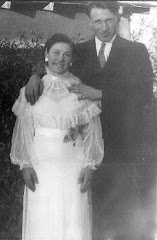




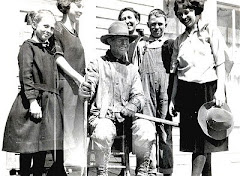

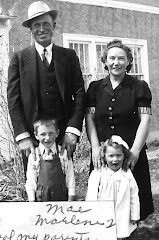
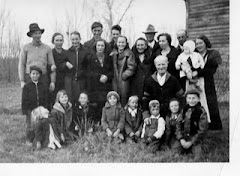
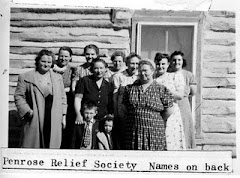
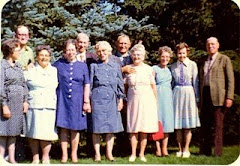


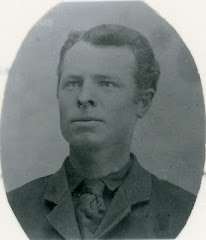


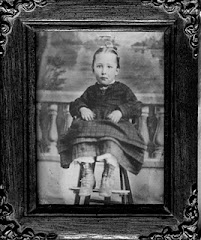


This comment has been removed by a blog administrator.
ReplyDelete